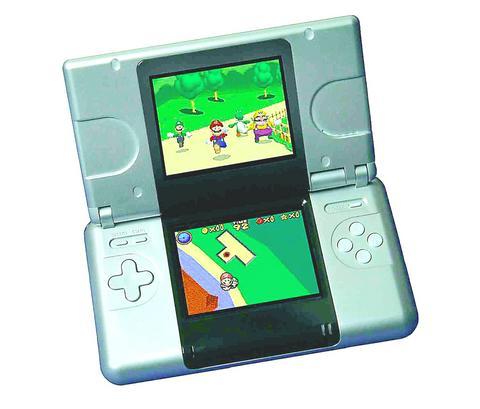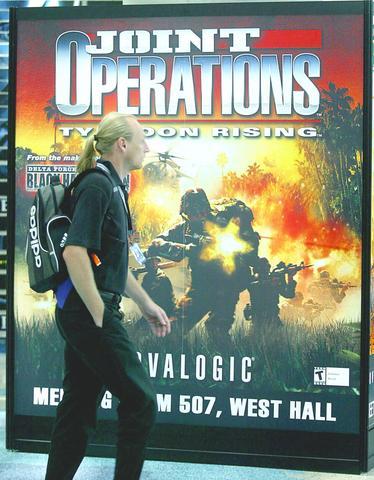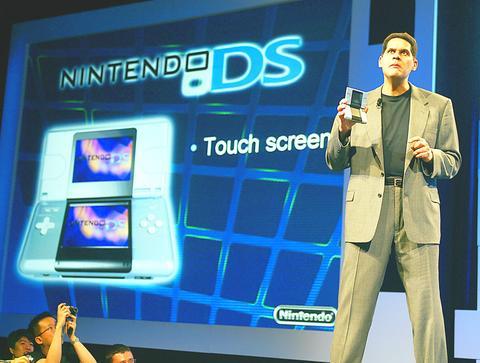There are exciting times ahead in the world of electronic entertainment, although they can be hard to identify in the din and cacophony of the Electronic Entertainment Exposition (E3).
The industry's biggest trade fair kicked off with an ear-splitting preview in Los Angeles on Tuesday as row after row of game makers and hardware manufacturers showed off their latest offerings with the help of scantily clad models, booming gunfire that would scare even hardened troops and graphics that edge ever-closer to the hyper-realistic holy grail of computer gaming.

E3 organizers said around 400 exhibiting companies from 70 countries are at this year's show, the 10th annual, which sprawls over more than 48,000m2.

PHOTO: DPA
The size of the gathering testifies to its popularity. The NPD Group, which tracks the industry, said videogame retail sales in the US -- including software, hardware, personal-computer games and accessories -- totalled US$11.2 billion last year with worldwide sales estimated to be double that figure. And that was in a down year, when sales were low because major consoles are getting long in the tooth and customers began waiting for the new models to hit the showrooms.
Most of the big news from the four-day confab was well-known in advance. There are upgrades for Microsoft's Xbox console, which is gradually gaining on Sony's PlayStation 2; product announcements from Nintendo and Sony about new portable gaming consoles that will spark a new handheld war for the hearts of male teens and the pockets of their parents; and a host of new game announcements, including new versions of such old faves as Doom and Halo.

PHOTO: REUTERS
The new consoles that will debut at the end of next year will feature revolutionary new processors that will improve graphic power and allow the consoles to take their rightful place in the digital-entertainment networks that are becoming ever more common in tech-savvy homes.
To keep sales up until then, Sony announced it was dropping the price of its PS2 to US$149 to attract more soft-core gamers.
Microsoft, meanwhile, was intent on improving the already impressive features of its Xbox. It unveiled a live videoconferencing feature for its consoles, allowing up to five players to see and speak to each other as they blast away.
Another significant announcement for the Xbox was the news that publishing giant Electronic Arts will finally start to produce games for it.
Since conventional wisdom states that any console is only as good as the games it plays, the deal gives a real boost to Microsoft's dream of surpassing Sony as the industry's leading
console.
"This is what gamers have been clamoring for in the past couple of years," said Cameron Ferroni, general manager of Xbox Live at Microsoft, with only a hint of hype.
Usually sober analysts raved that the deal might actually help Microsoft surpass Sony in console sales for the first time in history.
It could also prove a huge boost to Microsoft Chairman Bill Gates, who hopes that the Xbox can eventually offset Microsoft's slower growth in software sales for personal computers.
Since its 2000 debut, the Xbox has sucked up to US$2 billion from Microsoft's massive coffers, trailing the best-selling PS2 in distant second place with sales of 15 million units compared to 70 million units for the Sony.
But recent industry figures have shown the Xbox to be gaining momentum, and in April, it sold about the same number of consoles as Sony. The Xbox was a huge gamble for Microsoft, and it's finally starting to pay off, said Matt Rosoff, an analyst at the
independent research firm Directions on Microsoft.
Such a trend would be ominous for Sony, whose executives are well aware of how ruthlessly Microsoft plays catch-up. Similar tactics helped Microsoft drive Internet pioneer Netscape out of business, and with Sony relying on the PS2 for most of its profits, the writing is on the wall for the iconic Japanese company.
Sony has said it hopes that its entry into the handheld gaming market might give birth to a new cash cow and is even touting its PSP, which it is displaying for the first time in Los Angeles, as the Walkman of the 21st century.
The comment refers to Sony's then-revolutionary portable cassette player of the late 1970s that epitomized the company's leadership of consumer electronics. But Sony has largely missed out so far on the latest wave of portables. From PDAs (personal digital assistants) to MP3 players and handheld games, the Japanese giant has been a digital also-ran. But with the ability to play movies, games and music, the PSP marks Sony's bold attempt to leapfrog the entire field.
Business 2.0 magazine has already dubbed the machine the iPod killer, predicting that it will mark the beginning of the end for Apple Computer's dominant MP3 player. But first it will have to beat a new device from Nintendo, which virtually owns the mobile game space with its Game Boy Advance and which plans to extend its dominance with the Game Boy Double Screen, which features two LCD screens and two microprocessors and promises to introduce a completely new style of gaming.
The market will have to wait until next year at least to see who wins these fascinating battles. But one thing is for sure: As always in the electronic entertainment industry, some of the most exciting contests will continue to take place behind the screens.

May 26 to June 1 When the Qing Dynasty first took control over many parts of Taiwan in 1684, it roughly continued the Kingdom of Tungning’s administrative borders (see below), setting up one prefecture and three counties. The actual area of control covered today’s Chiayi, Tainan and Kaohsiung. The administrative center was in Taiwan Prefecture, in today’s Tainan. But as Han settlement expanded and due to rebellions and other international incidents, the administrative units became more complex. By the time Taiwan became a province of the Qing in 1887, there were three prefectures, eleven counties, three subprefectures and one directly-administered prefecture, with

It’s an enormous dome of colorful glass, something between the Sistine Chapel and a Marc Chagall fresco. And yet, it’s just a subway station. Formosa Boulevard is the heart of Kaohsiung’s mass transit system. In metro terms, it’s modest: the only transfer station in a network with just two lines. But it’s a landmark nonetheless: a civic space that serves as much more than a point of transit. On a hot Sunday, the corridors and vast halls are filled with a market selling everything from second-hand clothes to toys and house decorations. It’s just one of the many events the station hosts,

Two moves show Taichung Mayor Lu Shiow-yen (盧秀燕) is gunning for Chinese Nationalist Party (KMT) party chair and the 2028 presidential election. Technically, these are not yet “officially” official, but by the rules of Taiwan politics, she is now on the dance floor. Earlier this month Lu confirmed in an interview in Japan’s Nikkei that she was considering running for KMT chair. This is not new news, but according to reports from her camp she previously was still considering the case for and against running. By choosing a respected, international news outlet, she declared it to the world. While the outside world

Through art and storytelling, La Benida Hui empowers children to become environmental heroes, using everything from SpongeBob to microorganisms to reimagine their relationship with nature. “I tell the students that they have superpowers. It needs to be emphasized that their choices can make a difference,” says Hui, an environmental artist and education specialist. For her second year as Badou Elementary’s artist in residence, Hui leads creative lessons on environmental protection, where students reflect on their relationship with nature and transform beach waste into artworks. Standing in lush green hills overlooking the ocean with land extending into the intertidal zone, the school in Keelung